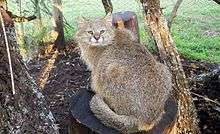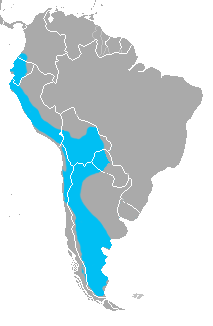Pampas cat
| Pampas cat | |
|---|---|
 | |
| Pampas cat with the third pelage type (see text) | |
| Scientific classification | |
| Kingdom: | Animalia |
| Phylum: | Chordata |
| Class: | Mammalia |
| Order: | Carnivora |
| Family: | Felidae |
| Genus: | Leopardus |
| Species: | L. pajeros |
| Binomial name | |
| Leopardus pajeros[2] (Desmarest, 1816) | |
 | |
| Pampas cat range map | |
The Pampas cat (Leopardus pajeros) is a small cat native to Argentina, Chile, Bolivia, Peru, Ecuador,[2] and possibly far southwestern Colombia.[1] It is named after the pampas, but occurs in grassland, shrubland, and dry forest at elevations up to 5,000 m (16,000 ft).[3]
It has traditionally been included in the colocolo (L. colocolo), but was split primarily based on differences in pelage colour/pattern and cranial measurements.[3] The split is not supported by genetic work,[4][5] leading some authorities to maintain it as a subspecies of the colocolo.[1][6] Confusingly, when the colocolo includes the Pampas cat and Pantanal cat as subspecies, the "combined" species is sometimes referred to as the Pampas cat.[7]
The Pampas cat is currently classified as "Near Threatened" in the IUCN Red List as habitat conversion and destruction may cause the population to decline in the future.[1]
Pampas cats have not been studied much in the wild and little is known about their hunting habits. There have been reports of the cat hunting rodents and birds at night, and also hunting domestic poultry near farms.
Subspecies
In 2005, Mammal Species of the World recognised five subspecies of the Pampas cat:[2]
- L. p. pajeros (nominate) – southern Chile and widely in Argentina[6]
- L. p. crespoi – eastern slope of the Andes in northwestern Argentina[3]
- L. p. garleppi – Andes in Peru[3]
- L. p. steinbachi – Andes in Bolivia[3]
- L. p. thomasi – Andes in Ecuador[3]
Based on two specimens, the subspecies L. p. steinbachi is larger and paler than P. l. garleppi. However, this is labelled with uncertainty due to the very small sample,[3] and some treat it as a synonym of L. p. garleppi.[6] Uncertainty also exists for the subspecies L. p. budini, which appears to resemble L. p. crespoi, and was described from lowlands of northwestern Argentina, but may actually be from humid forests in the region.[3] Some recognise it,[6] while other do not.[2] Finally, populations in southern Chile and the southern half of Argentina, included in the nominate in the above list, have been recognised as the subspecies L. p. crucinus based on the large size (the largest Pampas cats) and dull pelage (third type, see Description).[3]
Habitat
Despite being named after the Pampas, the Pampas cat occurs in a wide range of habitats. In northwestern Argentina, Bolivia, Peru, and Ecuador, it is found at altitudes between 1,800 and 5,000 m (5,900 and 16,400 ft) in páramo, marginally also in puna and locally in dry forest.[3] Where its range overlaps with the Andean mountain cat in northwestern Argentina, it occurs at lower altitudes on average.[8] In central to northwestern Argentina, the Pampas cat is found at altitudes below 1,240 m (4,070 ft) in grassland, mesophytic and dry forest, and shrubland.[3] In southern Argentina and far southern Chile, it is found in Patagonian steppes and shrubland at altitudes below 1,100 m (3,600 ft).[3]
Description
The Pampas cat is a small, but heavy-set cat. There are significant geographical variations in its size; the body length ranges from 46 to 75 cm (18 to 30 in) and the relatively short tail is 23 to 29 cm (9.1 to 11.4 in).[3] Three main variants of its pelage occur, but all have two dark lines on each cheek:
- 1) The first has flanks with large, reddish-brown, rosette-shaped spots with darker borders, numerous rings on the tail (of the same colour as the flank spots), and very dark brown (almost black) stripes on the legs and spots/stripes on the underparts.[3] In colour and pattern, this group closely resembles colocolos of the subspecies L. colocolo wolffsohni.[3]
- 2) The second resembles the first, but the background colour is paler, and the body markings, stripes on the hind legs, and rings on the tail are paler and less distinct.[3]
- 3) The third is overall greyish with distinct dark brown stripes on the legs and spots on the underparts, a plain tail (no clear rings), and at most indistinct dark lines on the flanks.[3]
Only the first type occurs in the north (around 20°S and northwards), and only the third type occurs in the far south (around 40°S and southwards).[3] In between, the majority are of second type, but the first type has been recorded as far south as 29°S, and the third type as far north as 36°S.[3] At latitudes where both the first and second type are found, the former tends to occur in highlands and the latter in lowlands.[3]
Melanistic Pampas cats have been reported.
References
- 1 2 3 4 Lucherini, M.; Eizirik, E.; de Oliveira, T.; Pereira, J.; Williams, R.S.R. (2016). "Leopardus colocolo". IUCN Red List of Threatened Species. Version 2016.2. International Union for Conservation of Nature.
- 1 2 3 4 Wozencraft, W.C. (2005). "Order Carnivora". In Wilson, D.E.; Reeder, D.M. Mammal Species of the World: A Taxonomic and Geographic Reference (3rd ed.). Johns Hopkins University Press. pp. 538–539. ISBN 978-0-8018-8221-0. OCLC 62265494.
- 1 2 3 4 5 6 7 8 9 10 11 12 13 14 15 16 17 18 19 20 Garcia-Perea, R. (1994). The pampas cat group (Genus Lynchailurus Severertzov 1858) (Carnivora: Felidae): A systematic and biogeographic review. American Museum Novitates 3096: 1–35.
- ↑ Johnson, Slattery, Erizirik, Kim, Raymond, Bonacic, Cambre, Crawshaw, Nunes, Seuánez, Moreira, Seymour, Simon, Swanson, & O'Brien (1999). Disparate phylogeographic patterns of molecular genetic variation in four closely related South American small cat species. Molecular Ecology 8: S79–94
- ↑ Macdonald, D., & Loveridge, A., eds. (2010). The Biology and Conservation of Wild Felids. Oxford University Press. ISBN 978-0-19-923445-5
- 1 2 3 4 Sunquist, M. E., & Sunquist, F. C. (2009). Colocolo (Leopardus colocolo). Pp. 146 in: Wildons, D. E., & Mittermeier, R. A. eds. (2009). Handbook of the Mammals of the World. Vol. 1. Lynx Edicions, Barcelona. ISBN 978-84-96553-49-1
- ↑ Novak, R. M., eds. (1999). Walker's Mammals of the World. Vol. 1. 6th edition. Johns Hopkins University Press, Baltimore. ISBN 0-8018-5789-9
- ↑ Perovic, P., Walker, S. & Novaro, A. (2003). New records of the Endangered Andean mountain cat in northern Argentina. Oryx 37: 374-377.
External links
| Wikispecies has information related to: Pampas cat |
| Wikimedia Commons has media related to Leopardus pajeros. |
- Species portrait Leopardus colocolo; IUCN/SSC Cat Specialist Group (L. braccatus and L. pajeros are not treated as separate species)
